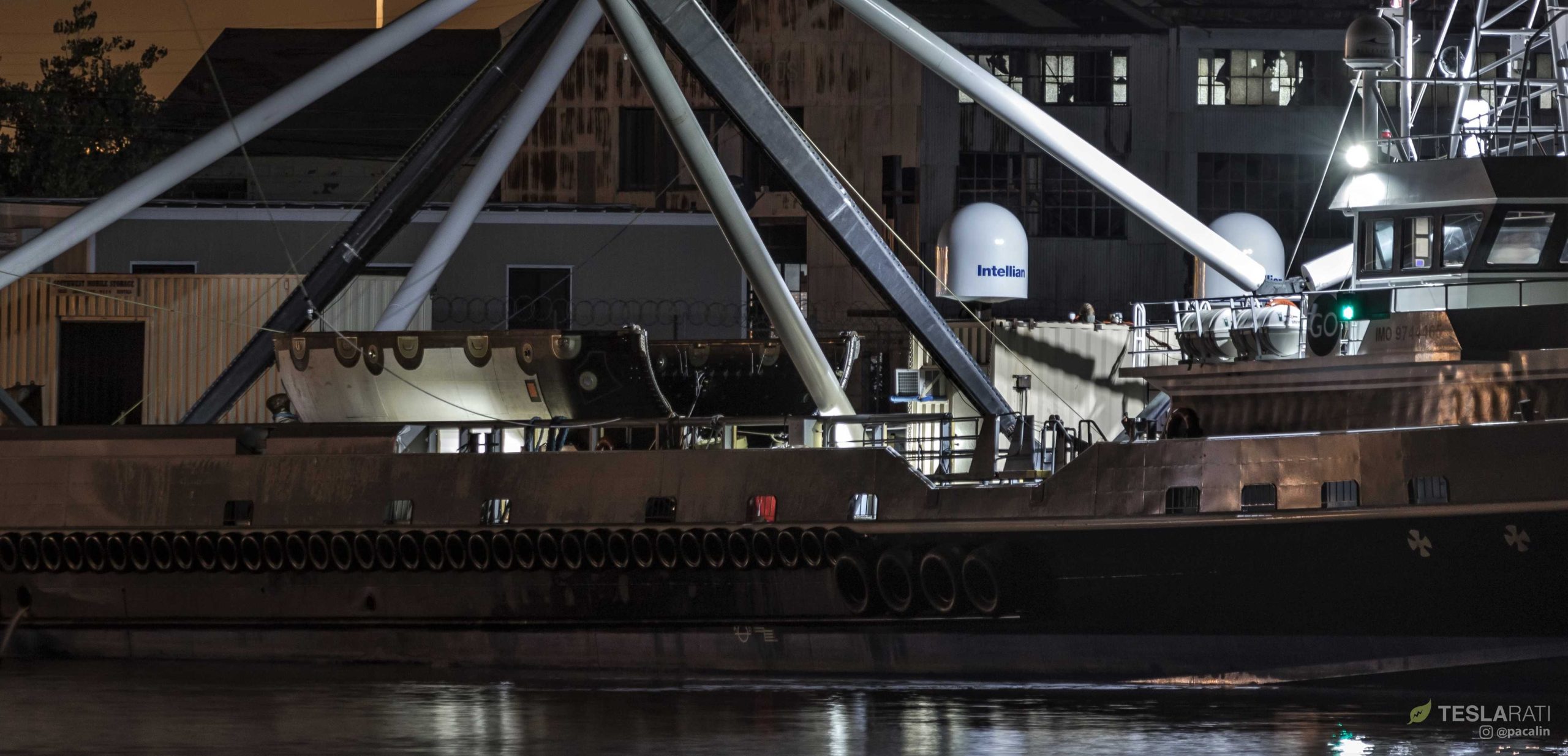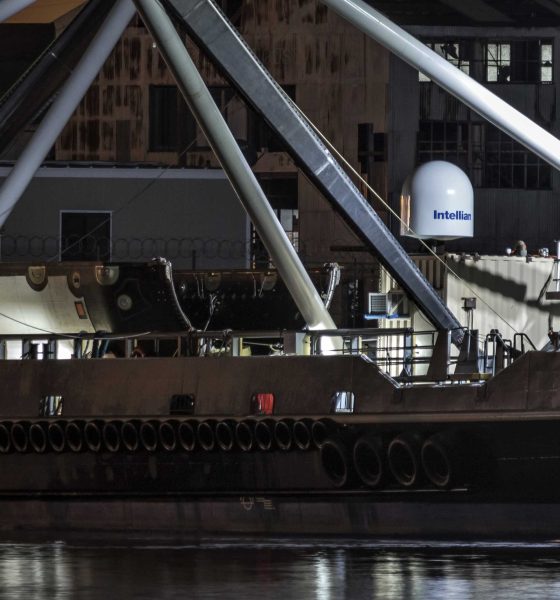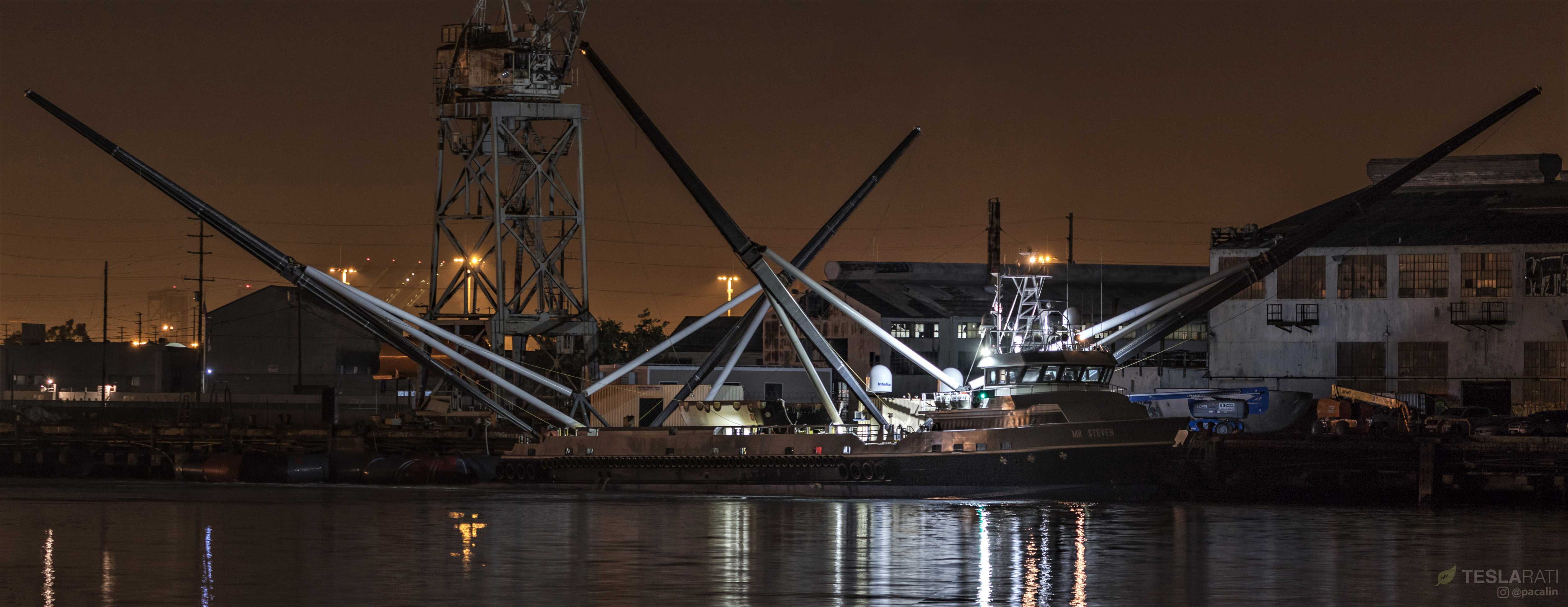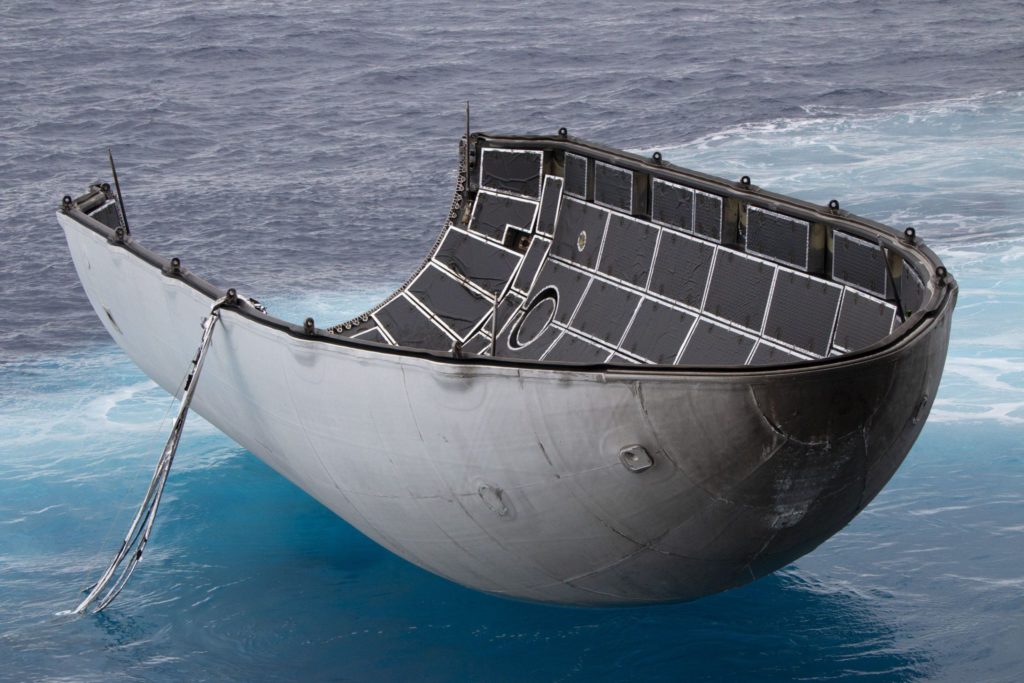

SpaceX
SpaceX’s Mr. Steven highlights ambiguity of Falcon fairing catches with port return
SpaceX’s fairing recovery vessel Mr. Steven highlighted the maddening and exhilarating uncertainty of unpublicized fairing recovery attempts with a return to Port of San Pedro on October 18th, the morning after spending a day at sea for the second Falcon fairing drop-and-catch test.
Teslarati photographer Pauline Acalin was on site to watch Mr. Steven’s 1AM Pacific port return and was able to capture the arrival, showing a familiar test fairing resting on the vessel’s deck, perfectly intact, with the recovery net fully retracted.

Schrödinger’s Fairing
Beginning with a dry run on October 8th, SpaceX technicians and engineers have spent the last 10 days testing Mr. Steven more intensely than ever previously observed, centering around a campaign of apparent Falcon fairing drop tests. Although it’s possible that these tests are more captive-carry trials than true drop tests, it seems more likely – judging by the fact that NOTAMs, notices to airmen, were only filed for 2 of the 3 attempts – that the helicopter is actually releasing a fairing half around 11,000 feet (3300 m) and letting it glide towards Mr. Steven.
Previously, SpaceX executive Hans Koenigsmann and CEO Elon Musk have mentioned a probable drop test campaign if operational (post-launch) fairing recovery attempts were unsuccessful. Mr. Steven has yet to successfully snag a fairing out of the air over the course of four post-launch catch attempts, evidence that – just like landing Falcon 9 boosters intact – recovering orbital-class rocket hardware in a state that allows for future reuse is extraordinarily difficult, regardless of the subsystem. However, SpaceX has managed to successfully recover fairing halves intact and in a condition good enough to make Koenigsmann, Vice President of Reliability, visibly excited during an IAC 2018 presentation.
- Hans Koenigsmann was extremely excited about the condition of this particular fairing half, and included this photo in his IAC 2018 keynote. (SpaceX)
- One half of SpaceX’s Iridium-6/GRACE-FO just moments before touchdown on the Pacific Ocean. (SpaceX)
- Close. (SpaceX)
The problem with those intact halves is that they have been recovered only after soft landings in the ocean – once immersed in saltwater, the sheer expense of cleaning a fairing to the point that it would be able to host another sensitive satellite payload is apparently too high to be worthwhile, at least from a perspective of economical reusability. The (quite literally) miniscule line that thus appears to be separating failed fairing recovery attempts from successes also means that it’s extraordinarily difficult to know whether the fairing half that returned on Mr. Steven yesterday morning is indicative of a breakthrough success or another successful failure.
Clearly, the fairing is perfectly intact from a purely structural perspective, meaning that its recovery hardware – cold gas thrusters and a parafoil – worked nominally. What is impossible to tell is whether its autonomous guidance systems were able to successfully direct it to Mr. Steven’s net, or whether Mr. Steven himself was able to maneuver beneath the falling fairing in time to catch it. And yet, a fairing half still sits visibly intact on Mr. Steven’s deck, story and fate unknown. With any luck, SpaceX will offer an official confirmation of some sort once success is in hand. For now, we wait.
For prompt updates, on-the-ground perspectives, and unique glimpses of SpaceX’s rocket recovery fleet check out our brand new LaunchPad and LandingZone newsletters!

Elon Musk
Starlink achieves major milestones in 2025 progress report
Starlink wrapped up 2025 with impressive growth, adding more than 4.6 million new active customers and expanding service to 35 additional countries, territories, and markets.

Starlink wrapped up 2025 with impressive growth, adding more than 4.6 million new active customers and expanding service to 35 additional countries, territories, and markets. The company also completed deployment of its first-generation Direct to Cell constellation, launching over 650 satellites in just 18 months to enable cellular connectivity.
SpaceX highlighted Starlink’s impressive 2025 progress in an extensive report.
Key achievements from Starlink’s 2025 Progress
Starlink connected over 4.6 million new customers with high-speed internet while bringing service to 35 more regions worldwide in 2025. Starlink is now connecting 9.2 million people worldwide. The service achieved this just weeks after hitting its 8 million customer milestone.
Starlink is now available in 155 markets, including areas that are unreachable by traditional ISPs. As per SpaceX, Starlink has also provided over 21 million airline passengers and 20 million cruise passengers with reliable high-speed internet connectivity during their travels.
Starlink Direct to Cell
Starlink’s Direct to Cell constellation, more than 650 satellites strong, has already connected over 12 million people at least once, marking a breakthrough in global mobile coverage.
Starlink Direct to Cell is currently rolled out to 22 countries and 6 continents, with over 6 million monthly customers. Starlink Direct to Cell also has 27 MNO partners to date.
“This year, SpaceX completed deployment of the first generation of the Starlink Direct to Cell constellation, with more than 650 satellites launched to low-Earth orbit in just 18 months. Starlink Direct to Cell has connected more than 12 million people, and counting, at least once, providing life-saving connectivity when people need it most,” SpaceX wrote.
Elon Musk
Starlink passes 9 million active customers just weeks after hitting 8 million
The milestone highlights the accelerating growth of Starlink, which has now been adding over 20,000 new users per day.

SpaceX’s Starlink satellite internet service has continued its rapid global expansion, surpassing 9 million active customers just weeks after crossing the 8 million mark.
The milestone highlights the accelerating growth of Starlink, which has now been adding over 20,000 new users per day.
9 million customers
In a post on X, SpaceX stated that Starlink now serves over 9 million active users across 155 countries, territories, and markets. The company reached 8 million customers in early November, meaning it added roughly 1 million subscribers in under seven weeks, or about 21,275 new users on average per day.
“Starlink is connecting more than 9M active customers with high-speed internet across 155 countries, territories, and many other markets,” Starlink wrote in a post on its official X account. SpaceX President Gwynne Shotwell also celebrated the milestone on X. “A huge thank you to all of our customers and congrats to the Starlink team for such an incredible product,” she wrote.
That growth rate reflects both rising demand for broadband in underserved regions and Starlink’s expanding satellite constellation, which now includes more than 9,000 low-Earth-orbit satellites designed to deliver high-speed, low-latency internet worldwide.
Starlink’s momentum
Starlink’s momentum has been building up. SpaceX reported 4.6 million Starlink customers in December 2024, followed by 7 million by August 2025, and 8 million customers in November. Independent data also suggests Starlink usage is rising sharply, with Cloudflare reporting that global web traffic from Starlink users more than doubled in 2025, as noted in an Insider report.
Starlink’s momentum is increasingly tied to SpaceX’s broader financial outlook. Elon Musk has said the satellite network is “by far” the company’s largest revenue driver, and reports suggest SpaceX may be positioning itself for an initial public offering as soon as next year, with valuations estimated as high as $1.5 trillion. Musk has also suggested in the past that Starlink could have its own IPO in the future.
News
SpaceX shades airline for seeking contract with Amazon’s Starlink rival

SpaceX employees, including its CEO Elon Musk, shaded American Airlines on social media this past weekend due to the company’s reported talks with Amazon’s Starlink rival, Leo.
Starlink has been adopted by several airlines, including United Airlines, Qatar Airways, Hawaiian Airlines, WestJet, Air France, airBaltic, and others. It has gained notoriety as an extremely solid, dependable, and reliable option for airline travel, as traditional options frequently cause users to lose connection to the internet.
Many airlines have made the switch, while others continue to mull the options available to them. American Airlines is one of them.
A report from Bloomberg indicates the airline is thinking of going with a Starlink rival owned by Amazon, called Leo. It was previously referred to as Project Kuiper.
American CEO Robert Isom said (via Bloomberg):
“While there’s Starlink, there are other low-Earth-orbit satellite opportunities that we can look at. We’re making sure that American is going to have what our customers need.”
Isom also said American has been in touch with Amazon about installing Leo on its aircraft, but he would not reveal the status of any discussions with the company.
The report caught the attention of Michael Nicolls, the Vice President of Starlink Engineering at SpaceX, who said:
“Only fly on airlines with good connectivity… and only one source of good connectivity at the moment…”
CEO Elon Musk replied to Nicolls by stating that American Airlines risks losing “a lot of customers if their connectivity solution fails.”
American Airlines will lose a lot of customers if their connectivity solution fails
— Elon Musk (@elonmusk) December 14, 2025
There are over 8,000 Starlink satellites in orbit currently, offering internet coverage in over 150 countries and territories globally. SpaceX expands its array of satellites nearly every week with launches from California and Florida, aiming to offer internet access to everyone across the globe.
Currently, the company is focusing on expanding into new markets, such as Africa and Asia.











